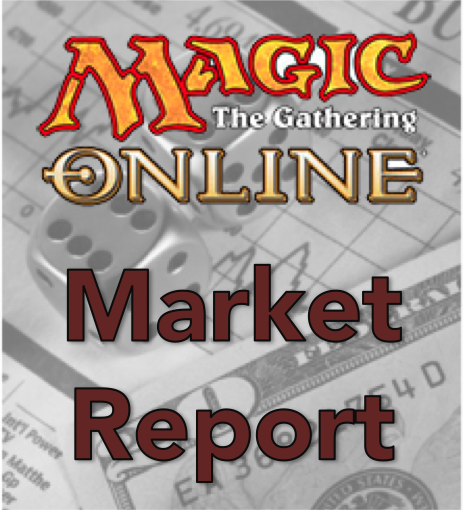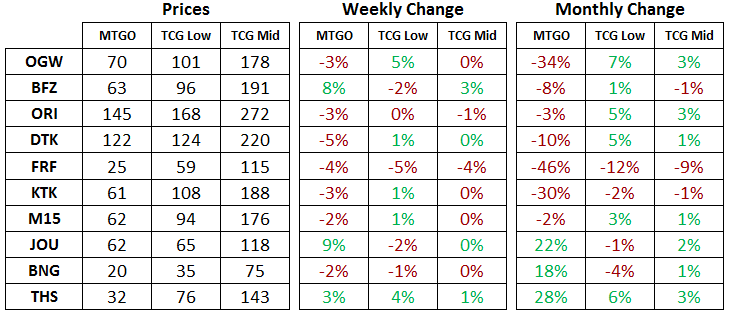Are you a Quiet Speculation member?
If not, now is a perfect time to join up! Our powerful tools, breaking-news analysis, and exclusive Discord channel will make sure you stay up to date and ahead of the curve.
Welcome to the MTGO Market Report as compiled by Matthew Lewis. The report will cover a range of topics, including a summary of set prices and price changes for redeemable sets, a look at the major trends in various constructed formats, and a "Trade of the Week" section that highlights a particular speculative strategy with an example and accompanying explanation.
As always, speculators should take into account their own budget, risk tolerance and current portfolio before buying or selling any digital objects. Questions will be answered and can be sent via private message or posted in the article comments.
Redemption
Below are the total set prices for all redeemable sets on MTGO. All prices are current as of March 21st, 2016. The TCG Low and TCG Mid prices are the sum of each set’s individual card prices on TCG Player, either the low price or the mid price respectively.
All MTGO set prices this week are taken from Goatbot’s website, and all weekly changes are now calculated relative to Goatbot’s ‘Full Set’ prices from the previous week. All monthly changes are also relative to the previous month prices, taken from Goatbot’s website at that time. Occasionally ‘Full Set’ prices are not available, and so estimated set prices are used instead.
Flashback Draft of the Week
This week one booster of Guildpact (GPT) gets added to the mix, along with two boosters of Ravnica: City of Guilds (RAV). The order of boosters being opened in draft will be RAV-RAV-GPT.
Adding the Izzet, Gruul and Orzhov guilds changes the dynamic around which colours combinations to look out for in this draft format. Where triple RAV was focused on the first four guilds introduced in that set, the addition of the next three guilds in GPT means the list of natural colour combinations to consider has expanded and changed at the same time.
From a top down perspective, Dimir drafters are base blue and black. Looking at the new guilds, a Dimir drafter could choose to move into either Izzet or Orzhov. In a similar way, a Selesnya drafter could seek to add black or red cards by moving into the Orzhov or Gruul guilds. Boros drafters can look to move into Orzhov or Izzet, and Golgari can move into Orzhov or Gruul.
As you can see, if players have stuck to the guild colours in the first two boosters, every drafter at the table might be looking to move into Orzhov, whereas Gruul or Izzet might be only half the drafters at the table. Orzhov also has powerful gold commons such as Pillory of the Sleepless and Blind Hunter to draw people in.
Keep this in mind when trying to figure out which direction to go in GPT. Gruul and Izzet might be open more often than Orzhov will be, just based on the boosters being opened.
There is also the dream of drafting the Temur wedge, having access to your pick of both Gruul and Izzet cards in GPT. This means avoiding choosing a guild in the first two boosters. While tricky to pull off, it's an unusual option to keep in mind that can yield powerful results.
Modern
A Magic Online Championship Series (MOCS) event was held this weekend featuring Modern Constructed. The top decks can be viewed here. Four of the top five played cards had the creature type of Eldrazi but there were some interesting builds battling with the Eldrazi decks.
This Bant deck featured the Standard combo of Collected Company and Reflector Mage. It also featured some novel cards in Meddling Mage, a card that can be excellent in a well defined metagame, as well as Phantasmal Image, this one as a four-of.
All of these cards are interesting pieces of technology to battle the Eldrazi, with the two mages combining to shut down key cards and the illusion to copy the biggest monsters on the battlefield. Should the Eldrazi continue to be a force in Modern come April, these types of cards will come under increasing demand.
Lastly, noted BGx master and Hall of Famer Willy Edel played an Abzan deck into the Top 8 of the MOCS. Alongside the usual assortment of discard spells, targeted removal and creatures, there was Oath of Nissa from Oath of the Gatewatch (OGW) as a four-of.
This is an early sign that this card could be a Modern staple. Performing triple duty in card selection, powering up Tarmogoyf and making it easier to cast Liliana of the Veil is an impressive trick and exactly what you want out of the one-mana slot in your curve.
Standard
With Shadows over Innistrad (SOI) spoilers in full swing and nearly half the set spoiled, brewers are already imagining what Standard will be like with the new set and without Khans of Tarkir (KTK) and Fate Reforged (FRF). All Standard sets except for Battle for Zendikar (BFZ) saw declines this week, as the majority of players and bots look past the current format to the new Standard coming in April.
With the rest of Spring and Summer for Dragons of Tarkir (DTK) and Magic Origins (ORI) to be played in Standard, there will be opportunities for speculators to target cards from these sets that get a boost due to Standard rotation or renewed interest in Modern, post-Eldrazi banning. Cards like Kolaghan's Command have been edging down to the previous price level and have already shown a marked tendency to cycle between highs and lows.
For those not willing to try and time the market, it's a good time to be deploying tix into baskets of BFZ and OGW cards. Both sets are still being opened in limited play and have a relatively high supply as a result. After SOI's release, supply from boosters being cracked will dry up and prices will start to drift upward as the market finds a new equilibrium.
If you are unsure of what to target, buying BFZ and OGW sets or baskets of cards from these sets is way to diversify and capture broad-based gains over time, without having to predict how an individual card will fare in Standard.
Standard Boosters
There's not much to report this week for boosters. OGW and BFZ boosters have been in a gradual decline and this is expected to continue up to the release of SOI. At that time, look for a sharp decline as the liquidity crunch generated by the new set's release takes a bite out of all prices. Speculators would be well advised to build up their stash of tix in advance of SOI release events.
Elsewhere, KTK and FRF boosters continue their terminal decline. Pending rotation leading into declining singles and set prices, leading to declining interest from drafters, is a vicious cycle that will continue for the next month. Steer well clear of these until the signs of a price bottom start showing up.
Trade of the Week
As usual, the portfolio is available at this link. For background theory on this week's trade, be sure to read up on how the prices of foil mythic rares evolve over time as detailed in my three part column from last year.
This week I moved heavily into OGW foil mythic rares after doing some number crunching. In the table below, I took the sum of the prices of foil mythic rares from the most recent sets, and calculated the average cost of foil mythic rares from each these sets. All prices were current as of Friday, March 18th, 2016.
| Mythic Count | Total Cost | Average Cost | |
| OGW | 12 | 129 | 10.7 |
| BFZ | 15 | 220 | 14.6 |
| ORI | 16 | 299 | 18.7 |
| DTK | 15 | 262 | 17.5 |
| FRF | 10 | 149 | 14.9 |
| KTK | 15 | 379 | 25.2 |
What stood out to me right away was how low the average cost was for OGW foil mythic rares at nearly 30% below the BFZ and FRF average. With OGW currently being opened in draft and sealed leagues, it struck me that this difference will turn out to be temporary and that once SOI hits in April prices will start rising on OGW foil mythic rares.
When considering the upside on this trade, it's unlikely that the OGW foil mythic rare average price will rise to the level of KTK. That set is an outlier due to the presence of the allied fetchlands. Reaching an average in the 14 to 18 tix range seems like a reasonable expectation based off of recent history. This suggests an upside of 30% to 70% on the average foil mythic rare from OGW.
Foil mythic rares are not very liquid so moving large amounts of tix into these will be difficult. Buying one of each or a playset of each is doable though. It's important to diversify in this regard as it's not predictable which mythic rare will rise the most.







I’m a big fan of basket strategies (sets, foil mythic, boosters) – mainly because they drive a lot more from the economics of supply and demand rather than magic. A lot of the patterns are cyclic and more predictable, and I’m not good enough at the game itself to be able to read cards confidently to spec.
With regards to the Foil Mythic Strategy in your earlier article my takeaway is to focus on the junk mythics as a means of profiting off the paper foil multiplier of the chase mythics. What are your thoughts on a cutoff approach by buying say, the bottom 4 or 5 (bottom ~25%) foil mythics ranked by price? It would be less speculative than picking individuals but also avoiding tying up tix in top end cards like Chandra FC?
At this point, I would not be able to recommend any particular basket approach beyond getting them all.
For ORI, if you had avoided Jace, you would have missed out on massive gains.
For BFZ, if you had avoided Gideon, you would have been better off as the price has come down from 30+ tix.
OGW has a very flat price distribution between the mythic rares relative to these two sets, so you would probably be best served by getting the complete basket.
Of note, for SOI, be sure to avoid the double faced mythic rares as these will be showing up at a higher frequency due to the printing and collating process around double faced cards. Over time, this will depress their prices and the rest of the mythic rares will a little extra accrue value.